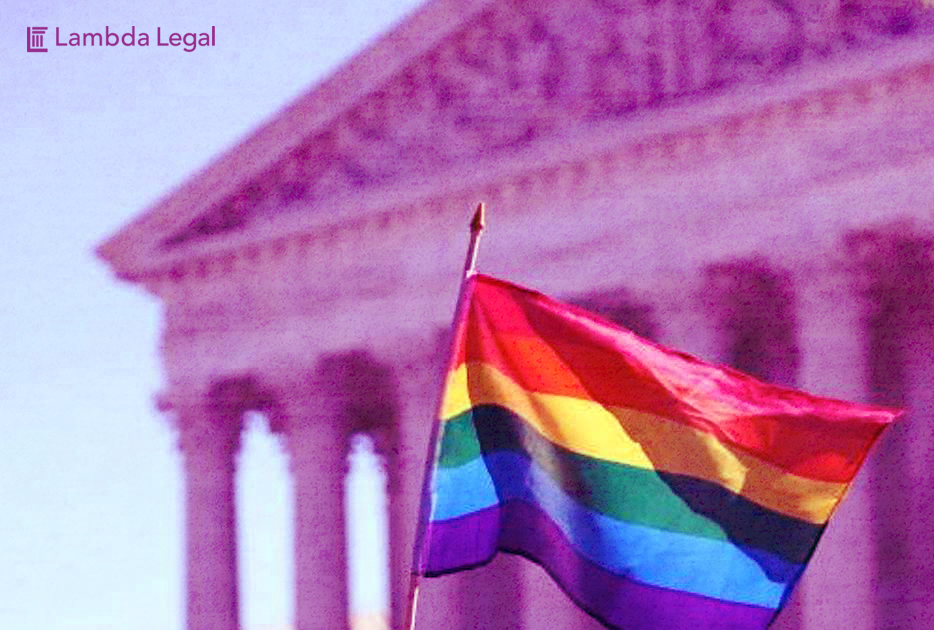By Omar Gonzalez-Pagan, Senior Attorney and Health Care Strategist, and Greg Nevins, Senior Counsel and Employment Fairness Project Director.
Well, it finally happened. We walked out of the room where the Supreme Court heard oral argument in the trio of cases that will decide whether existing federal law – specifically the ban on sex discrimination in Title VII of the Civil Rights Act of 1964 – forbids discrimination against LGBTQ employees.
First thing’s first: there was no statement from any justice that gave away the result in either case – like, for instance, “One more question, counsel, and we will put you out of your misery,” an actual final question to opposing counsel during oral argument in our Glenn v. Brumby win for transgender employees in the Eleventh Circuit. The judge who asked that wasn’t kidding; the court had its written decision out five days later, a near-record in federal appellates where national security or the fate of a presidential election is not involved.
But what actually happened at the Supreme Court today, and what do we think it means for the future of these cases?
After filing two amicus briefs in Zarda/Bostock and Stephens, as well as shepherding numerous other briefs, such as the brief on behalf of 206 corporations in support of these plaintiffs, we were in the courtroom today and were able to witness this historic moment.
Here are some significant points that stood out to us.
Will the text win the day?
Many of the Supreme Court Justices’ questions focused on whether the text of the statute (Title VII of the Civil Rights Act) can be read to apply to instances of discrimination based on an employee’s sexual orientation or gender identity. And indeed we argue that such is the case. Justice Alito pushed back by trying to say that sexual orientation discrimination and sex discrimination are distinct concepts. But Pam Karlan, who argued the sexual orientation cases on our side, rightly pointed out that sex was always at play and that sexual orientation discrimination itself is an amalgamation of the distinct forms of discrimination faced by LGB people, for example. In the end, at least five justices, including Ginsburg, Breyer, Sotomayor, Kagan, and Gorsuch, appeared to indicate there were reasonable arguments that the text applies in such contexts.
What about “Congressional intent”?
Opponents of protections for LGBTQ employees, which sadly now includes the so-called Department of Justice, argued that Congress never intended for Title VII’s sex discrimination provisions to apply to discrimination based on sexual orientation or transgender status. But even assuming that is the case, the Supreme Court has repeatedly recognized as prohibited forms of discrimination never envisioned by Congress in 1964, such as sex stereotyping and sexual harassment. (Pam Karlan made a rather witty reference to 1964 as the “Mad Men” era when making this point.) Our opponents also tried to argue that the inclusion in totally unrelated subsequent legislation of sexual orientation and gender identity, coupled with Congress’s failure to pass ENDA or now the Equality Act, somehow serves as evidence of what Congress intended in 1964. Justice Kagan in turn pointed out that it is the text – and not congressional intent or legislative history (then or after) – that controls the way we interpret the law. Indeed, the Solicitor General was forced to concede that should the court find that the text clearly applies to instances of LGBTQ discrimination, they would lose notwithstanding their appeals to congressional intent. However, Justice Gorsuch wondered if congressional intent matters when the application of the text is a “close call.”
What impact will existing sex discrimination precedents have?
At various times, advocates and justices brought up how Title VII’s sex discrimination prohibition covers sexual harassment, including same-sex harassment, and sex stereotyping. That is because neither were conceived of by Congress in 1964, yet a handful of precedents make clear that these are prohibited forms of sex discrimination. Among these are Price Waterhouse v. Hopkins in 1989, in which the Court held that Price Waterhouse’s consideration of Ann Hopkins’s nonconformance with how women should behave or act was unlawful sex discrimination, and Oncale v. Sundowner Offshore Services, Inc. in 1998, in which the Court held that harassment from one male employee against another was unlawful sex discrimination under Title VII. In other words, as Justice Ginsburg repeatedly admonished, Title VII was intended to strike against the “full spectrum” of disparate treatment because of sex.
The “parade of horribles” distraction.
Opponents of protections for LGBTQ employees dramatically argued that the Court’s decision in these cases would affect everything from the existence of dress codes to single-sex facilities (like restrooms). And while some questioning occurred around this area, three things stood out. One, Justice Gorsuch wondered if a ruling in favor of the LGBTQ employees would cause “massive upheaval.” But the ACLU’s David Cole had a quick response – really a reality check – which is that these protections have been recognized by federal courts for decades, and no such upheaval has happened. (Nor has it happened in response to states with explicit prohibitions on discrimination based on sexual orientation or gender identity.) Second, the advocates brought back the focus on the individuals in these cases: Aimee Stephens, Donald Zarda, and Gerald Bostock – because Title VII protects individuals and not classes. And third, some of the justices tried to focus the arguments on the question in these cases: whether Stephens, Zarda, and Bostock were fired because of their sex. As Justice Kagan noted, the Supreme Court articulated a very simple test in 1978 to determine whether sex discrimination has occurred, which is: “whether the evidence shows treatment of a person in a manner which but for that person’s sex would be different.”
What impact will our other Supreme Court victories have?
We heard little today about the effect of the Supreme Court’s decisions holding that every adult has the right to form intimate relationships and marry irrespective of their sex and the sex of their beloved. The conventional wisdom is that the members of the Court who did not support those decisions will be the least likely to agree with the employees. But those decisions are rulings of the Court itself now, and not merely the five/six justices who so ruled. That fact is not lost on the justices who did not agree when those decisions were issued, most notably Chief Justice Roberts, who has often publicly expressed an intense concern regarding the public’s perception of the Court as a legitimate, stable court of law that does not change course merely because of an increase in the number of justices appointed by the president of a given party. Of course, Justice Ginsburg noted how, in 1964, sexual orientation was not a concept defined in dictionaries, how there were many states that made it criminal for men to engage in sodomy, and how homosexuality was considered a mental disorder. And Justice Breyer wondered how the Court’s decisions in Lawrence, Windsor, and Obergefell may come into play. Ultimately, we don’t know how the profound change in the overall legal landscape for the LGBTQ community will affect the outcome of this case. However, there is little doubt from the questions today that the fact that the arguments presented would have been given short shrift a few decades ago is causing the justices to appreciate that the firings of Aimee Stephens, Donald Zarda, and Gerald Bostock were because of sex. Whether that appreciation results in agreement remains to be seen.
What’s next?
As far as how this plays out from here: the justices will meet in conference on Friday to take an initial vote on the outcome of these cases. If Chief Justice Roberts is in the majority, he will either write the majority opinion himself or give it to a justice of his choosing (while he theoretically has unbridled discretion in doing so, the Court does carefully balance who writes how many opinions each month). If he is not in the majority, the option of writing or assigning goes to Clarence Thomas, if he’s in the majority. And if he isn’t, then the writing/assigning task goes to Ruth Bader Ginsburg. We can pretty much assume that one of those three will be in the majority.
When will we find out the outcome of these cases?
A decision can come at any time now. It can be a matter of a few weeks to a few months; the Supreme Court has until the end of term in June 2020 to issue its decision. But for what it’s worth, we expect a decision sometime in the first half of 2020. While decisions in the last three major LGBTQ cases decided by the Supreme Court – that is, Lawrence, Windsor, and Obergefell – were each handed down on June 26th, those cases were argued much later in the term than these. A decision here is likely to come earlier than that, given that today is the just the second day of the term.
So, what do we think?
From all appearances today, the Supreme Court will be addressing head-on the question of whether Aimee Stephens, Donald Zarda, and Gerald Bostock were fired because of their sex and whether such discrimination is a form of sex discrimination prohibited by Title VII of the Civil Rights Act. We cannot predict what the court will do, nor do we know when their decision will come down.
We do know, however, as we await the outcome of this historic moment, that we will continue to fight for LGBTQ people in the workplace. Whether it is by representing Jennifer Eller in her lawsuit against Prince George’s County Public Schools for the discrimination and harassment she endured on account of being transgender, or by suing North Carolina state officials for their discriminatory exclusion of transition-related health care in the state employee health plan, we stand ready to continue achieving positive change for LGBTQ workers around the country. We are your lawyers, after all.





